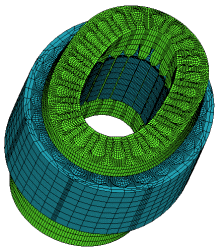Contents
1. Introduction
2. Existing Challenges and Initiatives in This Paper
3. Specification of Target Motor
4. Results of Electromagnetic Field Analysis
5. Measurement of Motor Vibration / Noise While in Operation
6. Structural Analysis Modeling
7. Conclusion
8. References
1. Introduction
While miniaturization and efficiency optimization are always in demand in motor development, demand is also increasing for the reduction of vibration and noise in recent years. As a tool to solve these problems in development, anticipation for the coupled electromagnetic field and structural analysis has been on the rise. Vibration and noise of electric motors are caused by electromagnetic vibration as an excitation source, as well as resonance and amplification of the structure. In order to simulate this mechanism with CAE, an electromagnetic field analysis is first used to accurately reproduce electromagnetic phenomena and obtain electromagnetic force distribution, and then a vibration and noise analysis is performed using the acquired electromagnetic force as input to evaluate whether or not harmful resonance exists in the structure.
2. Existing Challenges and Initiatives in This Paper
There are several papers on the structural analysis of motors, and it is difficult to model a fastening structure for each part theoretically. To generate a highly accurate structural model, many have reported ways to modify analysis models based on experimentation.
The objective of this study is to provide analysis techniques necessary for the simulation of vibration noise in motors.
In this study, we aim to provide the analysis technology necessary for vibration noise simulation indirectly, by first increasing the accuracy of the structural analysis model by modifying it using experimental modal analysis results, next running a vibration noise simulation, and then reporting the process.
This paper reports on the techniques used for improving the accuracy of structural analysis models. As a result, we were able to acquire highly accurate structural analysis models.

Frequency – rotation speed – acceleration characteristics

Mode shape #5 of the stator
You need to sign in as a Regular JMAG Software User (paid user) or JMAG WEB MEMBER (free membership).
By registering as a JMAG WEB MEMBER, you can browse technical materials and other member-only contents for free.
If you are not registered, click the “Create an Account” button.
Create an Account Sign in



